March 2009
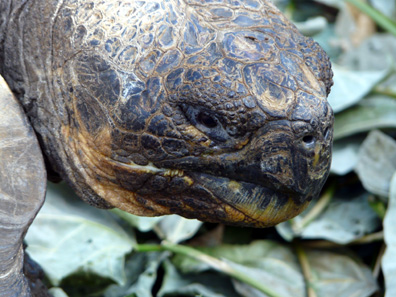
Giant Tortoise at the Galapaguera (tortoise reserve) on Isla San Cristobal
The Galapagos Islands
March 2009

Giant Tortoise at the Galapaguera (tortoise reserve) on Isla San Cristobal
There are 13 major islands in the Galapagos Archipelago which lies 373 km/600 miles from mainland Ecuador. This incredibly special place is home to plant and animal species whose ancestors floated here or were blown here. In 1959, in order to preserve the original ecology and to control the introduction of new and potentially harmful species, 90% of the land surface and all of the ocean out to the national limits was designated a national park. Indigenous fauna lives without natural predators, so the birds and animals are virtually fearless. Visitors can walk along trails and pass within inches of numerous species. We anchored in Puerto Baquerizo Moreno ("Wreck Bay") at Isla San Cristobal, the fifth largest island in the archipelago and the easternmost of the islands. It and Isla Santa Cruz are the only official ports of entry for people arriving on boats. A permit to visit more than one island on your own boat requires jumping through a myriad of hoops, much moolah, and a private cabin for the naturalist you are required to bring with you. Not having the moolah or the private cabin, we elected to stay at one island and take tours to other islands from there. |
|
| Isla San Cristobal
|
|
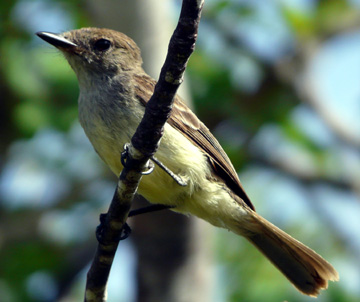
One of the many varieties of finch that Darwin determined were all descended from common ancestors that arrived thousands of years ago |
Who would think harmless little birds could harass cruisers into running away? A pair of fearlessly aggressive finches on a trail at the Charles Darwin Center flew repeatedly in our faces and buzzed our necks. We increased our pace across the sharp lava rocks to get out of their territory, which seemed inappropriately large for such small birds. |
Some of the giant tortoises at the Reserve are over 100 years old, proving that the tortoise does eventually win the race. When disturbed, they emit hissing noises and retreat into their shells. You can tell the females from the males by the size of their tails and the curvature of the rear part of their shells, but not until they're about 12 years old. Until then, it's anybody's guess. If you've never seen tortoises procreating on a nature documentary, you've missed the slowest sex on earth. The love session lasts for hours, and every few minutes the male emits a grunt that carries at least half a mile. Sorry, we didn't get any photos of tortoises getting it on. |
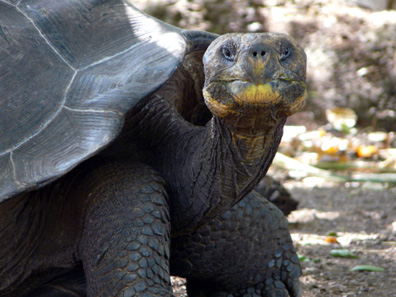
|
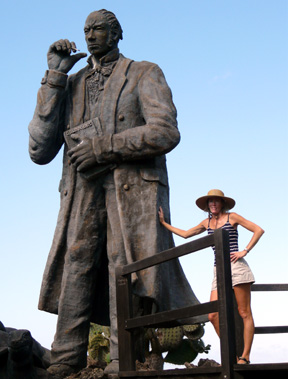
Erin getting friendly with Charles |
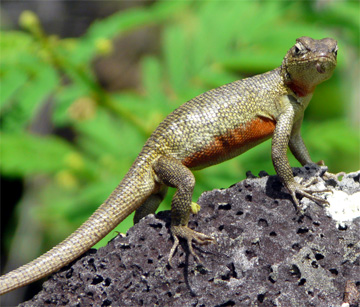
Lizards were plentiful on the trails near the Charles Darwin Center |
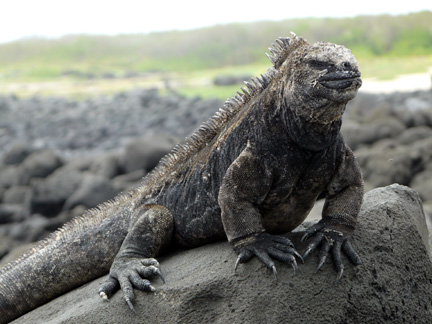 Sea iguana lording it over the rocks near La Loberia |
|
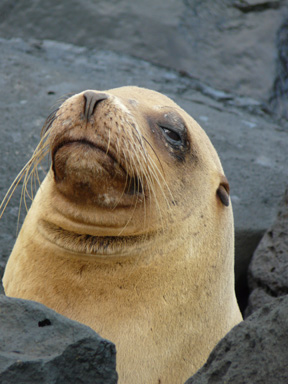
Sea lion near Wreck Bay |
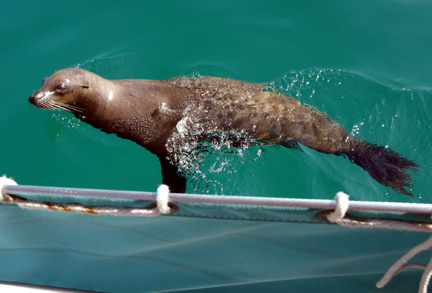
Luckily, our boat was too difficult for sea lions to access |
| We're no strangers to sea lions, but have never before lived in such close quarters with them. Their bleats, barks, and grunts were the soundtrack of Wreck Bay. One especially phlegmatic swimmer's loud, wet hacking always made me want to get a cough drop. Intestinal gurgling noises resounding through the boat meant a sea lion was blowing bubbles along our hull. Nursing pups sucked greedily at their complacent mothers lounging in the rocks along the water. Any unattended dinghy was filled with untoilet-trained sea lions within minutes. | |
| Scotland? Nope, this is at El Junco, a crater lake in the highlands of Isla San Cristobal. The islands use a combination of desalinization, rain water catchment, and wells to meet their fresh water needs. We read that water shortages are common, but didn't encounter any restrictions on water usage. | 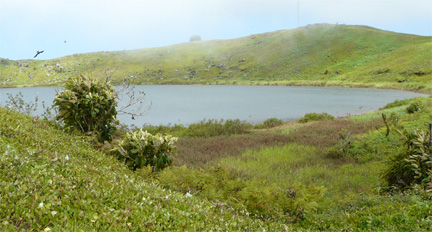
|
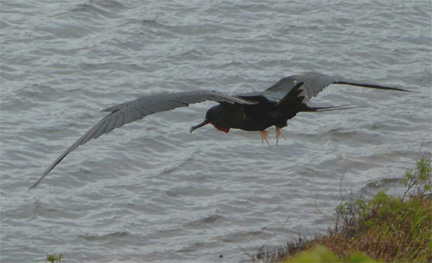
Male magnificent frigate bird (note the red throat poach--irresistible to females) |
Remember all those Susan B. Anthony coins that the government recalled a few years back? Well, we found out where they all ended up—Ecuador! They’ve been using U.S. dollars for over 12 years, and are happy to use the coins that were so often confused with quarters. |
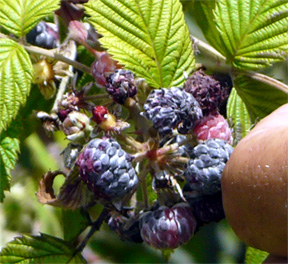
|
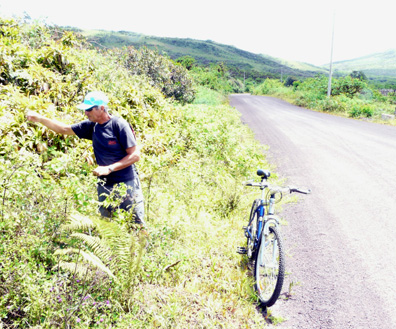
|
| Blackberry-picking was one of our favorite Pacific Northwest activities, but we never thought we'd be picking berries near the Equator! There were enough berries along the road near El Junco to make dozens of pies. We put down our rented bikes and contentedly stuffed our faces, knowing the more we ate, the fewer seeds from this invasive species would spread around the island. We were just doing community service. | |
Isla Isabella and Isla Santa Cruz |
|
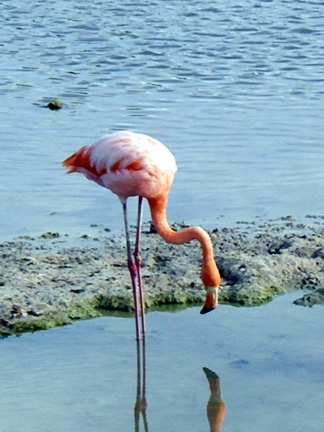
Pink flamingo feeding at the wetlands |
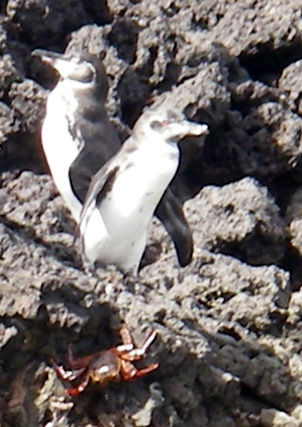
Strange to see penguins at the Equator |
The further west you move along the island group, the younger the islands. Isabella is one of the westernmost islands, so its jagged lava rocks haven't been subjected to as much erosion as the islands to the east. It's not as populated as San Cristobal and Santa Cruz. It's streets are all sand, and people seem more relaxed here, although they're still very keen to make a buck off the tourists. You might be surprised to know there are over 20,000 people residing on all the islands together, and over 10,000 people on Santa Cruz alone (the most populated island). Under a law passed in 1998, permanent resident status was granted to all citizens of Ecuador who were living on the islands at the time, but tight restrictions were applied to all subsequent immigration. This has greatly reduced the flow of poor mainland Ecuadorans hoping to make a better living in the Galapagos, but some still get in through vague temporary residency guidelines. We question who's doing more damage to the islands, the tourists or the residents? |
|
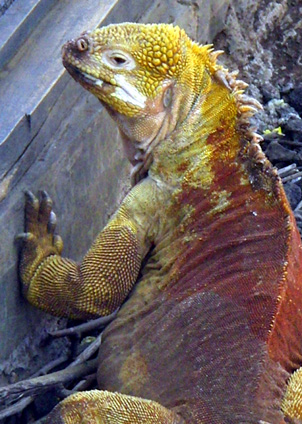
Land iguana in captivity. When a mockingbird landed close by, this iguana did a "push-up" to allow the bird to pick off parasites, but the bird hopped away, looking for better fare. |
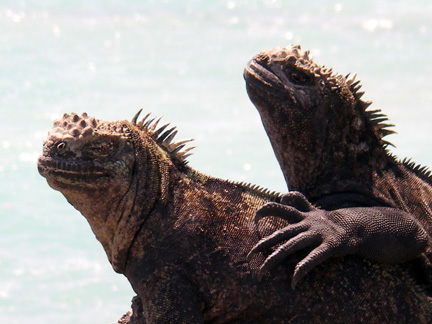
A pair of marine iguanas for comparison. They often sit interlinked in this friendly way. |
I wanted to see more animals, so Paul stayed with the boat in Wreck Bay on Isla San Cristobal while I ventured to Isla Isabella with a stop at Isla Santa Cruz. The two "ferries" turned out to be outboard-powered cabin cruisers. Comfort level depends on sea state, the amount of puke projected from small children, how much sun you're exposed to, and whether the captain is in a rush to get home. I enjoyed the sights, but spent a lot of time haggling with dishonest hotel owners and arranging tours. If I were to do it all over again, I would book a 5-day live-aboard boat tour for less hassle, more wildlife, and not much more money. |
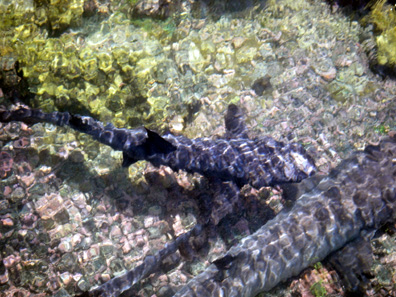
Galapagos white-tipped reef sharks |
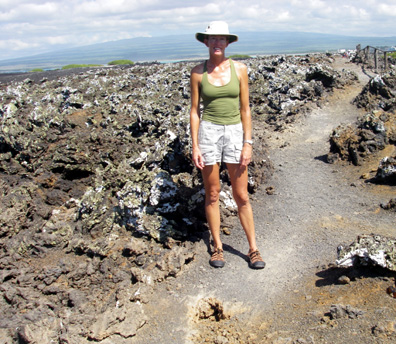
Jagged lava rocks at Las Tintoreras at Isla Isabella, one of the youngest islands |
I had some great experiences at Isabella and met some helpful people there and on Santa Cruz, but the constant price gouging left a bad taste. We're leaving this unique place with the feeling that the wildlife of Galapagos would be better off if tourism were eliminated. If there's no money to be made from tourism, most of the thousands of residents would leave, along with all their trash, sewage, landscaping, and construction projects. Development would come to a complete halt, and the flood of invasive species would end. This might seem harsh, but damage to the Galapagos Islands from mass tourism and a growing resident population is the reason a UN committee declared in 2007 that the islands are in danger of losing their world heritage site status. That's when Correa, president of Ecuador, imposed restrictions on tourist and residency permits in an attempt to control the damage. But how can you stop two resident kids from standing on their porch, scraping a large piece of styrofoam with forks to make "snow" that drifts all over the island? We saw this as well as plastic trash both on land and in the water. |
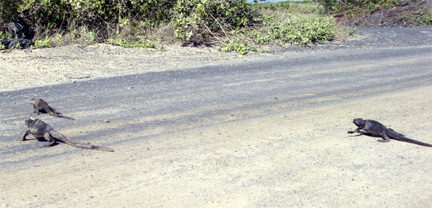
Marine iguanas crossing the road--there's even an "Iguana Crossing" sign! |
|
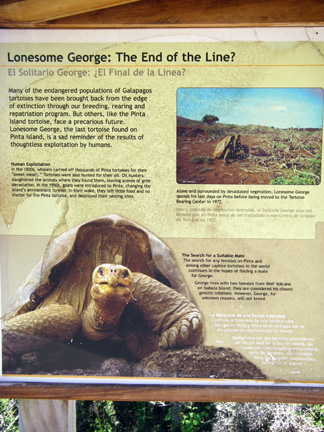
|
Lonesome George's story is a sad tale. In the 1800's, thousands of giant tortoises were placed in the holds of whaling ships. Since the tortoises could last for months without food and provided tasty meat when slaughtered, they were the convenience food of the day for sailors. The tortoises were also hunted for their oil. As if that weren't enough, on Isla Pinta, Lonesome George's original home, goats introduced in the 1950's consumed most of the vegetation the tortoises needed for food, shelter, and nesting sites. In 1972, when George was the last remaining tortoise on Isla Pinta, he was moved to a Tortoise Rearing Center on Isla Santa Cruz. Since every island has a different variety of giant tortoise, George is the last tortoise of his species. Despite living with a couple females considered his closest genetic relatives, George has shown no interest in breeding. The poor guy is probably too depressed! |
| I went on an intesting dive to Gordon Rocks, about 15 miles from Academy Bay, Isla Santa Cruz. The group consisted of an Israeli, two Danes, a Dutch girl, an Aussie, an Englishman, and two Americans. The other American wasn't certified and was introduced to SCUBA at an advanced dive site. That plus the 2+knot current, the low visibility, the cold water temperature, and the lax attitude of the “divemasters” made me a little uncomfortable. Safety standards here are definitely more, uh, "relaxed" than in the U.S. | 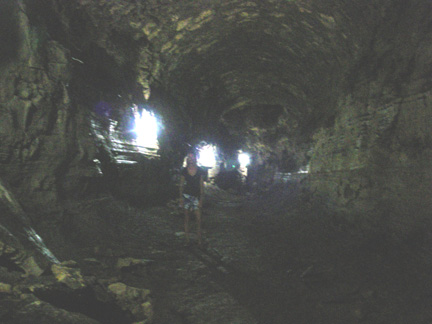
Lava tube on Santa Cruz |
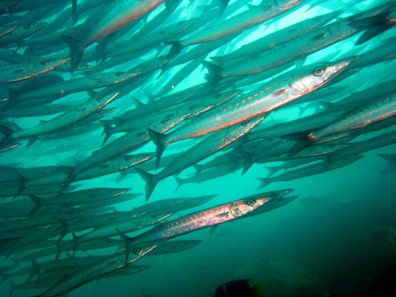
School of barracuda on the dive at North Seymour Island |
I was so cold, when we got to the second dive site at North Seymour Island, I wimped out and only snorkeled. The people who recommended this site to me saw giant manta rays and hammerheads there, so it’s just luck of the draw on any given day. I had my heart set on seeing one of four things: penguins or sea iguanas swimming above me, sea lions playfully swimming around me, or a giant manta ray floating slowly by. None of these things happened, but I enjoyed sitting in the bow of the boat zooming along at over 20 miles an hour on the return trip. Other people I met saw all those things at Gordon Rocks, so it's just luck of the draw. |
| Since almost everything must be shipped in, food costs are high in the Galapagos--$10 for a jar of P.B., and over $12 for a whole chicken!
The high food prices are preparing us for much greater sticker shock in French Polynesia, our next destination. |

|
| Next Page |